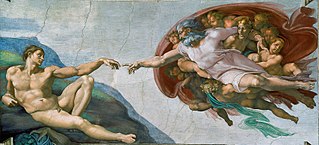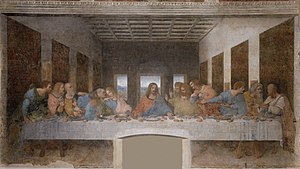
Fresco is a technique of mural painting executed upon freshly laid ("wet") lime plaster. Water is used as the vehicle for the dry-powder pigment to merge with the plaster, and with the setting of the plaster, the painting becomes an integral part of the wall. The word fresco is derived from the Italian adjective fresco meaning "fresh", and may thus be contrasted with fresco-secco or secco mural painting techniques, which are applied to dried plaster, to supplement painting in fresco. The fresco technique has been employed since antiquity and is closely associated with Italian Renaissance painting.

Leonardo di ser Piero da Vinci was an Italian polymath of the High Renaissance who was active as a painter, draughtsman, engineer, scientist, theorist, sculptor, and architect. While his fame initially rested on his achievements as a painter, he also became known for his notebooks, in which he made drawings and notes on a variety of subjects, including anatomy, astronomy, botany, cartography, painting, and paleontology. Leonardo is widely regarded to have been a genius who epitomized the Renaissance humanist ideal, and his collective works comprise a contribution to later generations of artists matched only by that of his younger contemporary, Michelangelo.

The Last Supper is a mural painting by the Italian High Renaissance artist Leonardo da Vinci, dated to c. 1495–1498. The painting represents the scene of the Last Supper of Jesus with the Twelve Apostles, as it is told in the Gospel of John – specifically the moment after Jesus announces that one of his apostles will betray him. Its handling of space, mastery of perspective, treatment of motion and complex display of human emotion has made it one of the Western world's most recognizable paintings and among Leonardo's most celebrated works. Some commentators consider it pivotal in inaugurating the transition into what is now termed the High Renaissance.

Andrea del Castagno or Andrea di Bartolo di Bargilla was an Italian Renaissance painter in Florence, influenced chiefly by Masaccio and Giotto di Bondone. His works include frescoes in Sant'Apollonia in Florence and the painted equestrian monument of Niccolò da Tolentino (1456) in Florence Cathedral. He in turn influenced the Ferrarese school of Cosmè Tura, Francesco del Cossa and Ercole de' Roberti.

The Basilica di Santa Croce is a minor basilica and the principal Franciscan church of Florence, Italy. It is situated on the Piazza di Santa Croce, about 800 metres southeast of the Duomo, on what was once marshland beyond the city walls. Being the burial place of some of the most illustrious Italians, such as Michelangelo, Galileo, Machiavelli, the poet Foscolo, the philosopher Gentile and the composer Rossini, it is also known as the Temple of the Italian Glories.

Santa Maria delle Grazie is a church and Dominican convent in Milan, northern Italy, and a UNESCO World Heritage Site. The convent contains the mural of The Last Supper by Leonardo da Vinci, which is in the refectory.
Lillian F. Schwartz is an American artist considered a pioneer of computer-mediated art and one of the first artists notable for basing almost her entire oeuvre on computational media. Many of her ground-breaking projects were done in the 1960s and 1970s, well before the desktop computer revolution made computer hardware and software widely available to artists.

The Battle of Anghiari (1505) was a planned painting by Leonardo da Vinci in the Salone dei Cinquecento in the Palazzo Vecchio, Florence. Its central scene would have depicted four men riding raging war horses engaged in a battle for possession of a standard at the Battle of Anghiari in 1440.

Marco d'Oggiono was an Italian Renaissance painter and a chief pupil of Leonardo da Vinci, many of whose works he copied.

Florentine painting or the Florentine School refers to artists in, from, or influenced by the naturalistic style developed in Florence in the 14th century, largely through the efforts of Giotto di Bondone, and in the 15th century the leading school of Western painting. Some of the best known painters of the earlier Florentine School are Fra Angelico, Botticelli, Filippo Lippi, the Ghirlandaio family, Masolino, and Masaccio.

Sister Plautilla Nelli (1524–1588) was a self-taught nun-artist and the first ever known female Renaissance painter of Florence. She was a nun of the Dominican convent of St. Catherine of Siena located in Piazza San Marco, Florence, and was heavily influenced by the teachings of Savonarola and by the artwork of Fra Bartolomeo.

Giovanni Donato da Montorfano was an Italian painter of the Renaissance who was born, lived, and worked in Milan.

The Last Supper of Jesus and the Twelve Apostles has been a popular subject in Christian art, often as part of a cycle showing the Life of Christ. Depictions of the Last Supper in Christian art date back to early Christianity and can be seen in the Catacombs of Rome.

The Italian Renaissance painter Domenico Ghirlandaio painted the Last Supper of Jesus three times, in separate fresco paintings in or near Florence. The oldest of the three is located in the Badia di Passignano (1476), next is the most famous one, painted in the refectory of the Convent of the Ognissanti (1480), and the last is at the Convent of San Marco (1486), the last two both in Florence itself.

The Last Supper (1445–1450) is a fresco by the Italian Renaissance artist Andrea del Castagno, located in the refectory of the convent of Sant'Apollonia, now the Museo di Cenacolo di Sant'Apollonia, and accessed through a door on Via Ventisette Aprile at the corner with Santa Reparata, in Florence, region of Tuscany. The painting depicts Jesus and the Apostles during the Last Supper, with Judas, unlike all the other apostles, sitting separately on the near side of the table, as is common in depictions of the Last Supper in Christian art.

Salvator Mundi is a painting attributed in whole or in part to the Italian High Renaissance artist Leonardo da Vinci, dated to c. 1499–1510. Long thought to be a copy of a lost original veiled with overpainting, it was rediscovered, restored, and included in a major exhibition of Leonardo's work at the National Gallery, London, in 2011–2012. Auction house Christie's stated just after selling the work in 2017 that most leading scholars consider it to be an original work by Leonardo, but this attribution has been disputed by other leading specialists, some of whom propose that he only contributed certain elements; and others who believe that the extensive damage prevents a definitive attribution.

The Sala delle Asse, is a large room in the Castello Sforzesco in Milan, the location of a painting in tempera on plaster by Leonardo da Vinci, dating from about 1498. Its walls and vaulted ceiling are decorated with "intertwining plants with fruits and monochromes of roots and rocks" and a canopy created by sixteen trees.

The Church of Our Lady of the Graces is a Gothic-style, Roman Catholic church in Varallo Sesia, province of Vercelli, region of Piedmont, Italy. The church was built, together with the adjacent Franciscan convent, by padre Bernardo Caimi between 1486 and 1493. At this time, the construction of the Sacro Monte was also beginning. In December 1931, Pope Pius XI gave the church the title of Minor Basilica.

Leonardo and the Last Supper, is a 2011 book written by Ross King, a Canadian novelist and non-fiction writer. He was awarded Canada's 2012 Governor General's Award for English-language non-fiction for Leonardo and the Last Supper, his examination of da Vinci's iconic 15th century religious mural.

The Last Supper is a tempera painting by Greek painter Michael Damaskinos. He painted in Heraklion, Sicily, Venice, and other parts of Italy. His painting of the Last Supper is considered the Greek Last Supper and is comparative to Leonardo da Vinci's masterpiece painted one hundred years prior. The two painters employed different painting styles but the subjects pose similarities. Damaskinos's painting features a feminine figure similar to that of Leonardo da Vinci's The Last Supper. The Damaskinos Last Supper is now in the Monastery of Agia Aikaterini in Heraklion, Crete. It is part of the collection of Saint Catherine's Monastery near Mount Sinai, Egypt.





















